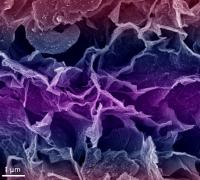How to treat cancer? An alternative to chemotherapy
Investigating the in vitro anticancer and cytotoxic properties of a new family of 2D titanium carbide and nitrate nanocrystals (MXenes) and their effect on cells is the main goal of a project implemented by Agnieszka Jastrzębska, Ph.D., Eng., of the Faculty of Materials Science and Engineering of the Warsaw University of Technology.
One of the main challenges facing contemporary societies is to solve the problem of cancer. The efficacy of the commonly used chemotherapy treatment and solutions consisting in the direct penetration of cells by therapeutics has recently been increasingly undermined. Therefore, researchers are now exploring other potential solutions. The material science approach has a chance to change the existing paradigm perspective.
“I would like my project to help the progress of nanomedicine and to contribute to the development of cancer treatments which will offer an alternative to chemotherapy,” says Agnieszka Jastrzębska, Ph.D., Eng.
In her work, she uses two-dimensional (2D) materials. In particular, she focuses on MXenes phases, due to their unique physical and chemical properties, as well as structure.
Is 2D more valuable than 3D?
“The properties of 2D materials differ substantially from those of their 3D counterparts,” explains the Warsaw University of Technology researcher. “Graphene, and its 3D counterpart graphite, is one of the best examples of this, as is the MXene phase, developed a little later.
As a 2D structure, graphene is a very good heat and electricity conductor, it is transparent and warrants high electron mobility. These properties set it distinctively apart from its 3D counterpart – graphite, which is a non-transparent, splintery mineral which abrades easily. The 2D structures of MXenes phases also have unique properties as opposed to the original well-known 3Ds. Such established, well-known 3D structures include the Mn+1AXn compounds with alternating metal and non-metal layers, known as MAX phases. They were first used in 2011 to generate MXenes phases.
This difference between the properties of 2D and 3D structures results in a continuous search for ways to transform other well-known layered tridimensional structures into two-dimensional ones with unique properties.
Promising research and ambitious plans
Our preliminary research, confirmed by data from literature, has found that it is possible to expand MAX phases to MXenes by eliminating one layer of the element from the crystalline structure,” explains Agnieszka Jastrzębska, Ph.D. “Moreover, through sonication in a liquid, we are able to delaminate MXenes into 2D structures of light transition metal carbides”.
In her project, the WUT researcher and her team intend to study two-dimensional nanocrystals of titanium carbides and nitrates with various stoichiometry (Ti3C2, Ti2C, Ti2N or Ti4N3).
“They were selected from among a very numerous group of MXenes phases as promising in the search for potential cancer treatments,” notes Agnieszka Jastrzębska, Ph.D., Eng. “They have very interesting properties that distinguish it from graphene, for example. First of all, it enables easy design of a “smart” structure which adapts to existing environmental conditions, actively interacts with the site that requires therapy and then undergoes complete decomposition and elimination from the body. We are also focusing strongly on potential cytotoxicity. Contrary to the current approach based on cell penetration, our 2D nanostructures avoid it, as penetration always causes oxidative stress. We want therapeutic structures to focus and work at the diseased site while posing no threat to the treated cells. MXenes’ ability to actively work outside the cell is fully sufficient to obtain the desired therapeutic effect.
We are planning to conduct primary research into the interaction between 2D nanocrystals of MXenes phases and cancer and normal cells in an in vitro setting. It will shed new light on their effect on the observed mechanisms.
Numerical methods will also be used in the project. They will be a valuable addition to experimental studies and they will make it possible to reduce the time and cost of testing.
Team development
“Another objective of the project is to establish a new research team focusing on innovative scientific solutions,” explains Agnieszka Jastrzębska, Ph.D. “It is a unique opportunity for a young scientist to build the team virtually from scratch”.
“Thanks to the funding we have obtained, my research team now has five young researchers (PhD students, undergraduate students, young technicians) strongly committed to the project and supporting its leader,” says Agnieszka Jastrzębska. “We are developing very dynamically and acquiring new funding, including the recent BIOTECHMED-1 grant as part of the Excellence Initiative – Research University of the Warsaw University of Technology. I am extremely proud of the work and scientific development of my young researchers and I support them strongly”.
The “Study of the anticancer properties of 2D titanium carbide and nitride nanocrystals – MXenes phases” project is financed by the National Science Centre (as part of the Sonata BIS 7 call).








